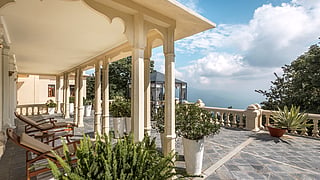- Locations
- Interviews
- Luxury Home
- Luxury Lifestyle
- Luxury Travel
- Luxury News
- Events
- More
- Magazine
- Contact Us

As heritage tourism rises, luxury hospitality is moving beyond surface-level design and into deeper values of cultural preservation, regenerative travel, and architectural storytelling. These four hotels—each rooted in a storied past yet reinvented for the modern traveler—embody how adaptive reuse is shaping the future of meaningful stays.
Once the site of Amsterdam’s first stone theater, The Dylan Amsterdam is a sanctuary of heritage, performance, and quiet luxury. Originally commissioned in 1638 by Jacob van Campen, the “Schouwburg” welcomed Vivaldi, Maria de Medici, and Rembrandt before a devastating fire transformed its role. In 1999, it was reimagined as a boutique hotel on the Keizersgracht, blending legacy with intimacy.
Today, the 41-room property marries history with refinement, from Studio Linse’s sensitive renovation to its two-Michelin-starred restaurant, Restaurant Vinkeles, housed in an 18th-century bakery. Its revival of Amsterdam’s oldest theatrical tradition, Gijsbreght van Aemstel, underscores the city’s enduring cultural narrative.
Celebrating Amsterdam’s 750th anniversary in October, The Dylan is unveiling refreshed interiors and historic details while reaffirming its Green Globe Gold certification.
Dining among original brick ovens and centuries-old atmosphere at Restaurant Vinkeles.
The Jacob van Campen Suite—a newly reimagined duplex with canal views and a dramatic, theatrical palette.
Set within the former Palace Estate of the Maharaja of Tehri-Garhwal, Ananda in the Himalayas carries both colonial echoes and a spiritual legacy. Commissioned in 1910–11 for a royal visit, the palace welcomed dignitaries and spiritual leaders like Ma Anandamayi. In 2000, it was reborn as India’s first destination spa, setting a global benchmark for wellness hospitality.
A three-year renovation restored colonial detailing and introduced new suites, while weaving Himalayan craft into the estate’s design. Guests find reflection in the preserved meditation rooms, restored woodwork, and a spa that remains one of Asia’s largest. With Oprah Winfrey, King Charles III, and Kate Winslet among its past visitors, the estate stands as both sanctuary and cultural inheritance.
Celebrating 25 years of innovation in 2025 with new design touches, diabetes management programs, and expanded sound healing offerings.
The 25,000-square-foot spa, home to Ayurvedic therapies, yoga pavilions, and daily Vedanta sessions.
The Viceregal Suite, with antique four-poster bed, private terrace, and valley views.
Though purpose-built in 1985, Hotel Belmar is a masterclass in regenerative hospitality. Inspired by alpine guesthouses, Pedro Belmar and Vera Zeledón’s vision became a cultural and ecological touchstone in Monteverde. Recent renovations by NAAS Interior Culture embraced adaptive reuse, preserving Costa Rican hardwoods and architectural character while infusing sustainable upgrades.
Local craftsmanship, organic textiles, and low-VOC finishes create harmony between structure and setting. Beyond architecture, Hotel Belmar expands its heritage through an artist residency program, linking biodiversity with cultural storytelling. Guests can join workshops, installations, and performances that place Monteverde at the forefront of regenerative travel.
Celebrating 40 years of eco-conscious hospitality with expanded circular agriculture and artist residencies.
Finca Madre Tierra, a carbon-neutral farm anchoring the hotel’s circular agriculture model.
The Nicoya Suite, with 270° views of forest and sea, a spa-inspired bathroom, and a suspended daybed above the canopy.
Opening in 2026, the Imperial Hotel, Kyoto marks a rare act of preservation in Japan’s hospitality landscape. It inhabits the Yasaka Kaikan, a 1936 theater that hosted performances and films before becoming a nationally registered cultural property.
The restoration, led by Obayashi Corporation, used the ikedori technique to preserve 16,387 original tiles while reintroducing Kyoto’s craft traditions under designer Tomoyuki Sakakida. With just 55 rooms, the hotel offers an intimate encounter with Japan’s architectural legacy. Guests can expect private balconies overlooking Gion’s Kaburenjo theater, where the sounds of shamisen still linger.
A milestone for the Imperial brand, honoring 135 years of excellence with its first new opening in three decades.
Preservation Wing guestrooms with original beams and cultural resonance.
The Imperial Suite, crowned by a symbolic gazebo and twin terraces overlooking Kyoto’s timeless cityscape.
Adaptive reuse is no longer a design choice—it’s a philosophy. From Amsterdam’s canals to Kyoto’s historic stages, these hotels underscore how regenerative travel preserves not only buildings, but the cultural memory they carry. As heritage tourism continues to shape luxury hospitality, the most meaningful stays are not built anew, but reborn.
Inspired by what you read?
Get more stories like this—plus exclusive guides and resident recommendations—delivered to your inbox. Subscribe to our exclusive newsletter
Resident may include affiliate links or sponsored content in our features. These partnerships support our publication and allow us to continue sharing stories and recommendations with our readers.